For people who have recently come to accept or are still struggling to manage one ostomy the news that they may need to have a second stoma and pouching system could be overwhelming. Please know you are not alone. Many people are able to thrive in life with two ostomies, or multiple diversions.
When UOAA hears from those with questions for a double ostomate we often refer them to ostomy community friend Jearlean Taylor. Jearlean wanted to share some advice and invite all double ostomates to her talk and open discussion entitled “Life as a Double Ostomate” on August 12, 2023 as part of UOAA’s National Conference in Houston, Texas.
Sharing with the community of double ostomates is so refreshing and exciting. It is true “we are not alone”. We can live our life as a double ostomate with joy.
I am Jearlean from Baltimore, Maryland. I am a double ostomate, fashion model, author, motivational speaker, entrepreneur, and ostomy advocate.
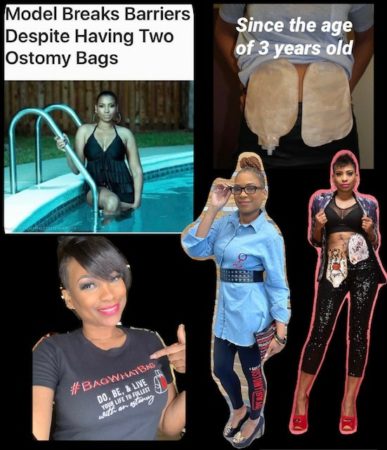
My life has had some unexpected outcomes. I guess you can say “life” happened. At the tender age of 3 years old I developed a rare form of cancer (Rhabdomyosarcoma). Because of the tumors I had to undergo ostomy surgery, which left me with two permanent ostomies (colostomy & urostomy).
If you or a child come to find you need a second ostomy my advice is to ADAPT. I had to learn to adapt. As I got older it was two major things for me to adapt; body and mind. When we hear two ostomies we get scared, but when we accept what we can’t change it says we are survivors. I adapted to new ways of taking care of my body (ostomies) and keeping my mind positive. Those still adapting to having two ostomies reflect how far you have come and where you are now. Celebrate each moment.
A Common question or statement I get is “you had your ostomies that long. How did you adapt?” The moment I learned to deal with my medical circumstance when my mom explained that I was not different from anyone else. I am beautiful with my bags. I can be, do, and follow my passions and dreams. I can live a full and vibrant life. It happened just as she said. Because of what she instilled in me, I BELIEVED IT.
When we hear two ostomies we get scared, but when we accept what we can’t change it says we are survivors.
Sharing with the community of double ostomates is so refreshing and exciting. It is true “we are not alone”. We can live our life as a double ostomate with joy. We are more than our ostomies.
I also try to give encouraging tips for dressing with an ostomy for comfort and peace of mind. Remember.
- We are beautiful from the inside out
- Work with your body type and comfort
- Look for clothing that YOU like ,and what is comfortable for your ostomies
- Shopping for clothing; take a family or friend along for support
- Try on multiple items of clothing, even the clothing in your closet
- Consider ostomy accessories (ostomy wraps, stealth belt, hernia belt, fitted tops, high waist undergarments, etc..)
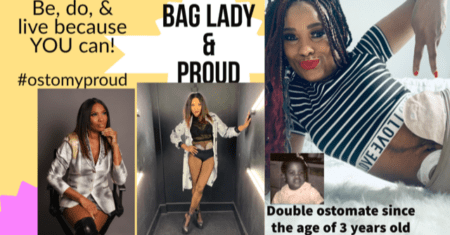
We have the ability to make a difference and change lives even through our struggles. You may have an ostomy, dealing with chronic illness, feeling down and inadequate at times, but remember you are more than you have become. Our situations, challenges, and unforeseen circumstances does not have to dictate who we are or who we can become. My purpose is to inform everyone that “life” happens to us all; good, bad, and indifferent. I want to show people even through our struggles, pain, disease, and even having ostomy we have a purpose in life.
“DIFFERENT TO MAKE A DIFFERENCE“
You can find Jearlean online at jearleantaylor.com and across social media. Meet her and a whole community of double ostomates at UOAA’s 8th National Conference August 10-12, 2023, In Houston Texas.
By Ed Pfueller, UOAA Communications Manager
Taylor Mitchell and Michael Ross
It was raining every day, for weeks, before Taylor and Michael were set to get married. But as the recently wed couple stepped out of the church for photos, only the sun was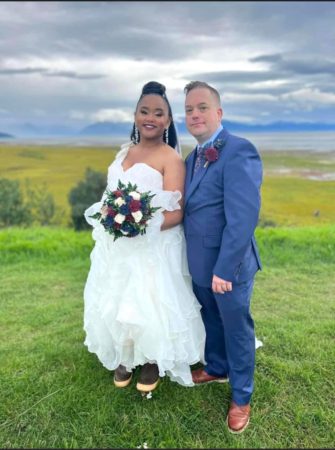 shining, a distant mountain range framed their joy – the chilly Alaskan rain held off.
shining, a distant mountain range framed their joy – the chilly Alaskan rain held off.
“It was an absolutely magical day,” says Taylor, the bride. “Taylor took my breath away when I saw her, she was absolutely stunning,” Michael recalls.
Even if the dark clouds had drenched their special day, it’s doubtful it would have dampened their mood. This specific couple is used to living with ostomies and chronic illness and they seem prepared to weather any storm.
Friends from the Start
Taylor and Michael first met ten years ago in a local college undergrad class. “I scanned the room, saw him, thought he was cute, and decided I wanted to sit by him and try to be friends. I didn’t know if anything would come of our friendship. We had a great connection as friends, Taylor recalls.
“She was smart, insightful, and easy on the eyes, but I would never have imagined she was interested in me beyond friendship,” Michael says.
The friendship slowly turned into dating. “We have a lot in common and also have a lot of differences. I love to plan, and she is more spontaneous. We both respect each other and can be vulnerable with each other, and the biggest thing is we trust each other,” Michael says.
Taylor says some things she loves about Michael is that he understands her and that they have a shared faith. “He always wants to help me any way he can, and he’s generous to others,” she says.
What is an Ostomy?
“While we were dating, I didn’t know Michael had an ostomy for a while and when he did tell me, I had no idea what it was,” Taylor says. “His ostomy was never an issue for me and so my experience while dating was positive! His ostomy never impacted anything in our relationship from my perspective.”
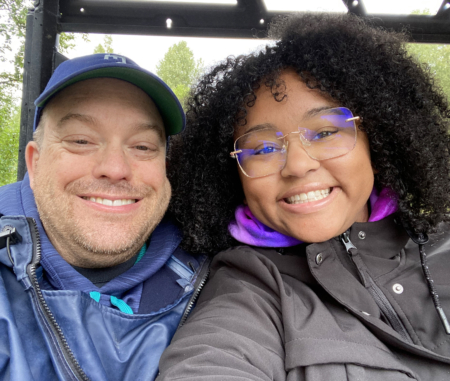
Michael has had a long ostomy journey and awareness, his mother had a urostomy. ”I had a colostomy for about two years, takedown for four, and have had a permanent ileostomy for the past fifteen years due to complications with Crohn’s disease,” he says.
“I didn’t date much before I met Taylor but had no negative experiences when I did date. Taylor was very understanding when I told her (and showed her) about my ostomy. She was very understanding and seemed eager to learn more.”
“My advice would be, if you’re a person who doesn’t have an ostomy and finds yourself dating someone with an ostomy, educate yourself and do your best to understand your partner, their limitations (if any), and then just treat them as a regular person!” Taylor says.
Taylor also advises that if you have an ostomy and find yourself with someone who doesn’t have an ostomy. “Give the partner an opportunity to accept you and make the choice for themselves on what they’re comfortable with. You’re not for everyone and that’s ok and vice versa! I think it will always be slightly nerve-wracking to have a body that isn’t “normal” by current beauty standards because of the fear of rejection and embarrassment, Taylor says. “Society tends to tell us that no one will want us if there’s something “wrong” with us. But, if you can muster the courage to put yourself out there, the outcome may be better than you ever imagined!”
I don’t think we will have any more challenges than the average couple… we just poop differently. -Michael Ross
In Sickness and in Health
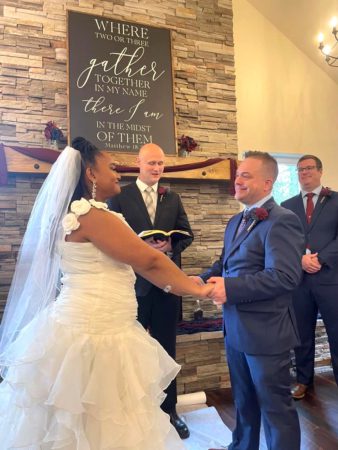 Caregiving has been a consistent part of Taylor and Michael’s relationship. “When Michael had to have revision surgery, I wanted to make sure he’d have easily accessible food so he could focus on healing. I came over to his house prior to surgery and we made a few different meals to freeze. It was a great feeling for me that we got to spend time together cooking and his food would be taken care of while he recovered. He was used to taking care of himself so it meant a lot to me to do this for him.”
Caregiving has been a consistent part of Taylor and Michael’s relationship. “When Michael had to have revision surgery, I wanted to make sure he’d have easily accessible food so he could focus on healing. I came over to his house prior to surgery and we made a few different meals to freeze. It was a great feeling for me that we got to spend time together cooking and his food would be taken care of while he recovered. He was used to taking care of himself so it meant a lot to me to do this for him.”
Meanwhile, Taylor started dealing with her own undiagnosed chronic illness. “I had to go to the Mayo Clinic while we were dating, and he took time off of work to come with me for a week. He came to all my appointments and helped me navigate all my emotions with what I was dealing with. This is the kind of thing we do for each other, we try to make the hard times easier by taking care of the small things and the big things,” she says.
Just a year and a half ago Taylor, with her health worsening Taylor had ostomy surgery as a result of chronic constipation. For better or worse they were now an ostomate couple.
A Couple of Ostomates
After her ostomy surgery, Taylor says she, “shared with him every single aspect of what I was going through. It was nice to be with someone who already knew! It felt good from my perspective to understand him better, now that we had the same appliance… I actually knew first-hand what he was dealing with.”
Michael says that one of the best parts of being with another ostomate is knowing that someone really understands what you are going through. “It’s nice to be able to compare notes on new products and understand when my partner isn’t feeling well, to have the option to share supplies, tag along to doctor’s appointments, and ask questions about care, procedures, and recovery,” he says.
In addition to a new mutual understanding of health issues, Taylor says, “We know what to do if one of us isn’t feeling well. We just understand each other on a deeper level. He accepts me as an individual and he accepts my body even as it changes with all my health challenges.”
It felt good from my perspective to understand him better, now that we had the same appliance… I actually knew first-hand what he was dealing with. -Taylor Mitchell
As for difficulties, they both dread a possible double leak at night, and can imagine the challenge of not feeling well at the same time or needing a procedure around the same time. Taylor says the most challenging part has been encouraging the other to stick to the foods that work for us, to drink water more consistently, and get our electrolytes in.” Michael concludes, “I don’t think we will have any more challenges than the average couple… we just poop differently.”
Finding Community and Support
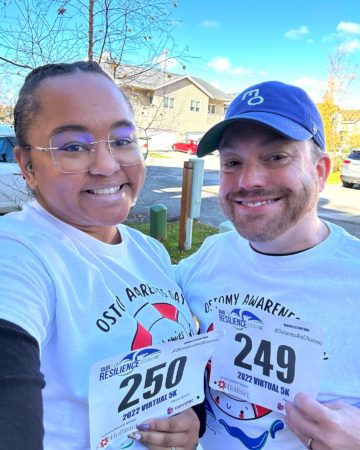 Even with partner support, Taylor says “UOAA has been so incredibly important to me in my ostomy journey. When I first got my ostomy, I scoured the UOAA website and read every piece of information I could find which helped ease my mind and answer my questions. UOAA’s website also helped me to be able to share information about my ostomy with family and friends.”
Even with partner support, Taylor says “UOAA has been so incredibly important to me in my ostomy journey. When I first got my ostomy, I scoured the UOAA website and read every piece of information I could find which helped ease my mind and answer my questions. UOAA’s website also helped me to be able to share information about my ostomy with family and friends.”
The couple, who both work in logistics, has recently moved to Colorado but while in Alaska both say they had the good fortune of having Luella Odmark as their WOC nurse.
“Luella is an amazing individual who cares so deeply about ostomates,” Taylor says. She does a training for nurses at one of our hospitals and has invited my husband and I to speak to the class about our ostomy history, give advice on what we wish we had from nurses, doctors, and hospital staff as well as sharing some of our favorite products,” she adds.
“I enjoyed observing the transformation of two people pursuing their own interests, coming together, including getting married, now mentoring others about ostomies,” says Odmark, a WOC Nurse and the leader of the Anchorage Ostomy Support Group. “I hope to see them continue to spread hope about living with an ostomy,” Odmark adds.
Odmark also joins the couple each Ostomy Awareness Day to walk the Run for Resilience Ostomy 5k. The experience was especially meaningful to Taylor. “The Ostomy 5k was a huge accomplishment the first time I did it because I was three months post op and it was a huge struggle for me to walk a 5k, I almost didn’t finish it and wanted to give up so many times. Taylor continues, “My second time, this year, it was still a hard thing for me to accomplish but I did so much better! I loved seeing people from all over doing their 5k however was comfortable for them. It was encouraging!”
UOAA has been so incredibly important to me in my ostomy journey. -Taylor Mitchell
Taylor is especially open about her ostomy journey and embraces Ostomy Awareness Day as a chance to connect with more people online and see their stories. “It’s such a nice feeling to know that I am not alone. I see people who are confident with their ostomy and I see people who are working to build their confidence,” Taylor says.
Taylor hopes to help even more people and nurses through UOAA outreach opportunities. “I love UOAA’s mission, I love the work they do, and I love all the resources that are available for FREE so financial barriers are removed for as many people as possible. Accessibility is so important! I am proud to be a supporter of UOAA.”
Michael agrees and adds, “I’m very thankful for all of the people that organize the walk, work with ostomates, and are around to help us on our ostomy journey. I’m most thankful for my wife, who I get to take this journey with every day.”
Written by Danielle Gulden and Joe Teeters
We all know that “laughter is the best medicine”! This year’s Ostomy Awareness Day Champions, Danielle Gulden and Joe Teeters, not only love that phrase, they live it! These two best friends, and co-founders of Double Baggin’ It are IBD warriors and permanent ileostomates. They’re also comedians, speakers and Two Best Friends without Buttholes! They truly believe in the power of laughter, humor, advocacy and awareness! Which is why they LOVE Ostomy Awareness Day! For them, every day is a chance to raise awareness. But Ostomy Awareness Day is a special day to reflect and celebrate their life-saving surgeries and the lives they were given back! They share their stories so that future, new and veteran ostomates know that they are not alone!
Danielle and Joe have each been living with Inflammatory Bowel Disease for over 29 years. Although their IBD and ostomy journeys have been quite different, their positive outlook on life and ridiculous sense of humor are the same!
Prior to 2014, Joe and Danielle had no idea the other existed…so, let’s rewind a few decades and learn about the journey of each of these Two Best Friends Without Buttholes!
Growing up, Danielle was a very healthy child, an extremely outgoing teen, and an adventurous free spirit! Spontaneity was her specialty, and travel was always her first love! Joe, on the other hand, always had “poop problems.” He was always pooping and known as “Joe the Pooper” by his siblings. Like Danielle, he was an outgoing, active, and social teenager.
Fast forward to Danielle’s late teens and early 20s. By the time she was a sophomore at The Ohio State University, Danielle’s health drastically changed! She saw her busy social life dissolve; she’d make plans and have to cancel. Spontaneity was no longer an option, and the idea of traveling was now a nightmare!
Danielle had to drop out of classes because of her poor health. Her symptoms and pain were becoming harder to ignore. She was in the bathroom around 25 times a day and became extremely malnourished and anemic.
You can hide your bag, but don’t ever let your bag hide you!
After being misdiagnosed for 6 years with a gluten intolerance, a colonoscopy in April of 1999 showed severe ulcerative colitis. From 1999 until 2007, Danielle’s life was a constant barrage of colonoscopies, radiological tests, bloodwork and pharmaceutical cocktails. She did the research and finally decided to have ostomy surgery.
After high school, Joe enlisted in the Naval Reserves. He passed the military physical and was cleared for training. While away, Joe’s poop problems became more pronounced, and the pain was gradually becoming more than just an annoyance.
When he returned home after 5 months, he was in the best physical shape of his life. On the outside he looked healthy, but inside something was wrong. Joe was initially diagnosed with irritable bowel syndrome, then a colonoscopy in 1993 lead to his diagnosis of severe Crohn’s Disease. Two years later he had his first intestinal resection. Joe’s Crohn’s continued to advance, and he had a second intestinal resection in October of 2004. 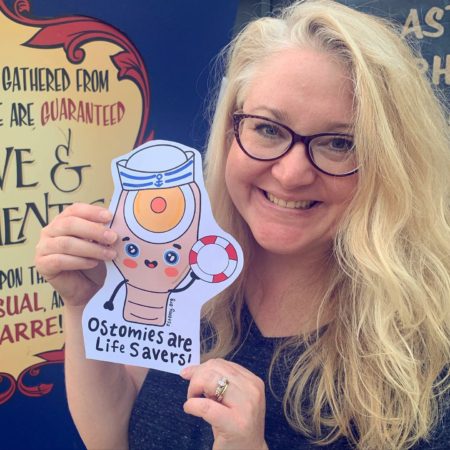
Back in Cleveland, Danielle was super excited for her ostomy surgery! She was ready to stop being a prisoner to her bathroom and get back to living her life to the fullest! On April 30th, 2007, Danielle had her total proctocolectomy with end ileostomy at the Cleveland Clinic. It was truly one of the greatest days of her life! She high fived every single person on the way to the OR.
From day one, she embraced her ostomy, and her new life as an ostomate. Within a month or two of her surgery, Danielle was back to exploring and enjoying her pre-sickness hobbies and joys. She traveled, hiked, camped, swam, went to concerts, and amusement parks. Life was good again! She also joined the Cleveland chapter of the UOAA and eventually became active on their executive board.
Fast forward a few years, and 120 miles away in Columbus, Ohio. Within a year of his second resection, Joe’s rectal Crohn’s disease became severe, and his rectum very strictured. After consulting with his GI and surgeon, Joe had a full proctocolectomy with end ileostomy on December 27th, 2012.
Joe’s recovery process and post-surgical experience was very different from Danielle’s. In addition to becoming an ostomate, the amount of bowel he had lost from three surgeries left him with Short Bowel Syndrome. It took the better part of a year to fully recover and return to pre-surgery activities.
During Joe’s recovery, a Facebook support group for ostomates became a lifeline. It was a great source of inspiration and hope, and a wonderful place that showed him he was not alone. Later, he sought out Central Ohio United Ostomy Association support group and became a member of the organization.
By now, you must be wondering how the heck these Two Best Friends Without Buttholes finally met. As you can see, they have traveled separate but similar paths in their battles with Crohn’s and ulcerative colitis. Their paths crossed in that Facebook support group mentioned earlier, when Danielle posted that she and her family were relocating to Columbus, Ohio. Joe, being a Columbus resident, and fellow ostomate, reached out and introduced himself. After meeting in person, in late 2014, at their local UOAA Affiliated Support Group, they started hanging out after the meetings. They soon discovered that they had a very similar outlook on life and shared a ridiculous sense of humor, and they wanted to use that to help others. A best friendship began…and slowly but surely, their vision for Double Baggin’ It was coming together. They decided to go to the United Ostomy Associations of America’s National Conference in September of 2015. There, after meeting over 400 ostomy patients like themselves, they decided to stop dreaming and start making their vision for Double Baggin’ It a reality. Double Baggin’ It was born, that week, when they filmed their first DBI video on a rooftop in downtown St Louis, Missouri.
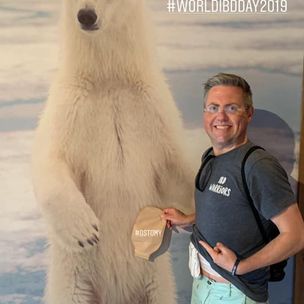
Through Double Baggin’ It, Danielle and Joe use their humor, wisdom, and stories to connect with and support other people living with ostomies and Inflammatory Bowel Disease. They advocate and raise awareness at the local and national level for both United Ostomy Associations of America and the Crohn’s and Colitis Foundation. Danielle and Joe also visit with their legislators yearly in Washington, DC to share their voices and stories.
You can find them on Facebook, Instagram, TikTok, Twitter and YouTube (@DoubleBagginIt) where you can watch them raise awareness through shenanigans and ostomy-bombing (placing an ostomy bag on a statue, landmark, anywhere they see fit!) They also can be found speaking at IBD and ostomy conferences, support groups, camps, hospitals and classrooms – sharing their stories and spreading laughter through improv. Danielle and Joe know that not everyone is comfortable rocking out with their bags out – and that’s totally ok! What these Two Best Friends Without Buttholes want to make perfectly clear, is that “You can hide your bag, but don’t ever let your bag hide you!”
Join with this year’s Ostomy Awareness Day Champions in spreading awareness by following Double Baggin’ It and UOAA on social media and visiting the Ostomy Awareness Day page to keep up to date on all the latest events.
Words and Photos by Jessica Miles
Living with a permanent ostomy can bring on significant changes in one’s personal, social and professional life. My biggest fear around having my ostomy surgery was leakage, particularly in public, skin breakdown and altered body image. There was a lot of trial and error in the beginning, but I have found what works for me as well as the confidence to share about it. I have always been an empath and very compassionate, however, I have now found a new passion for helping others (through my surgeon and on social media) learn how to manage their ostomy as well as how to cope with their new life. If you are willing and able to adapt, you can do anything!
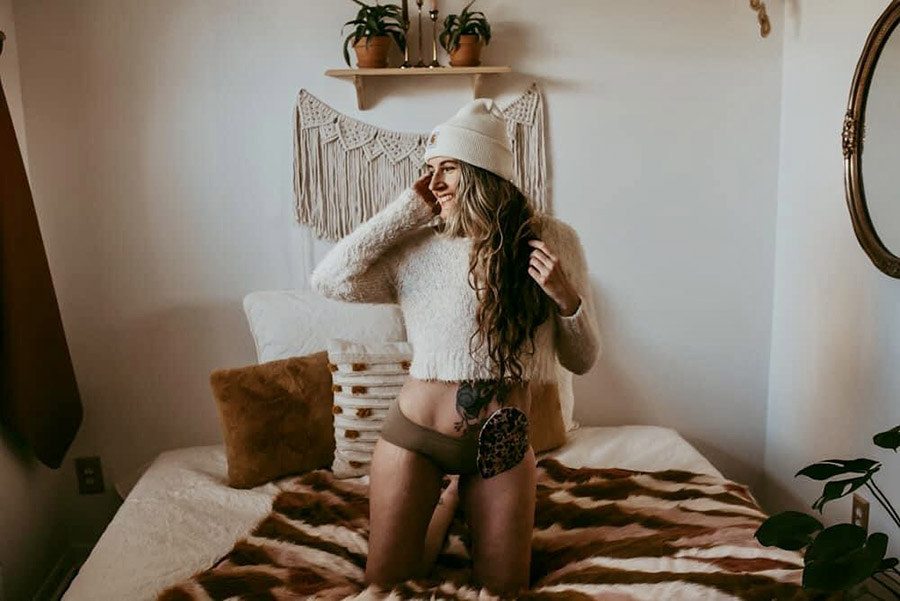
In 2016, after years of unexplained symptoms, countless procedures, hospitalizations, tests, and a couple of misdiagnoses, it was confirmed that I had a genetic connective tissue disorder caused by a defect in the protein collagen. I was diagnosed with Classical type Ehlers-Danlos Syndrome. More than 90% of people with Classical EDS have mutations in the COL5A1 or COL5A2 gene. I have a mutation of the COL5A2 gene. The condition is inherited in an autosomal dominant manner. Treatment and management is focused on preventing serious complications and relieving symptoms.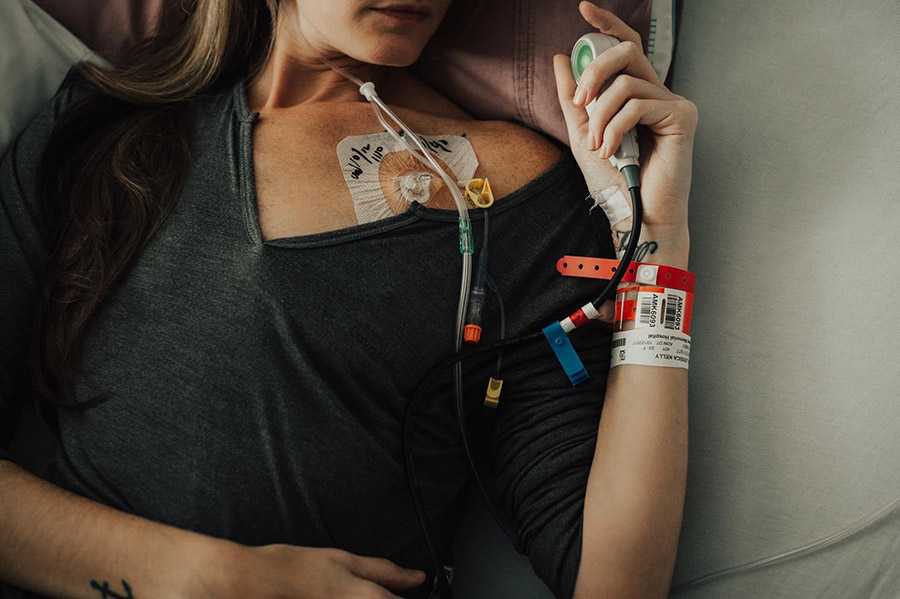
Classical EDS is associated with skin hyperextensibility, joint laxity, fragile blood vessels, joint hypermobility, migraines, joint and muscle pain. Some individuals with this subtype have a deformity of heart valves and may experience a dilatation of the aorta. In cEDS there is also an increased risk for aortic dissection. cEDS patients are prone to hernias and organ prolapse, as well as comorbidities such as autonomic dysfunction…which regulates heart rate, blood pressure, temperature, pupillary response and digestion.
I ended up having multiple surgeries over the past four and a half years due to intestinal dysmotility, prolapses and hernias, resulting in a port and a permanent ostomy. I now, have an ascending end colostomy. While I prepared for years for the possibility of having one, I realized nothing truly prepares you for the actuality of living with a bag on your belly for the rest of your life. Though little by little, the stigma took a back seat to the reality that life with an ostomy can be just as good, if not better for some, than life without one. I suffered constantly from abdominal pain, nausea, vomiting, bloating, constipation, bowel obstructions and malabsorption. While I still struggle with many debilitating symptoms of my disorder, I am now able to eat, gain weight and go to the bathroom regularly. Something I always took for granted until I was no longer able to do so.
My symptoms aren’t usually visible to the untrained eye, but they are life-altering for me.
Though I have a constant physical reminder of my condition in the ostomy, to the rest of the world, mine is a largely invisible illness.
 It’s hard to describe how I feel to someone who has no idea what daily life with a chronic illness is like. I feel awful on the inside but look perfectly fine on the outside. Putting on a brave face for all to see has become a habit. My symptoms aren’t usually visible to the untrained eye, but they are life-altering for me.
It’s hard to describe how I feel to someone who has no idea what daily life with a chronic illness is like. I feel awful on the inside but look perfectly fine on the outside. Putting on a brave face for all to see has become a habit. My symptoms aren’t usually visible to the untrained eye, but they are life-altering for me.
I’ve learned to take everything step by step and day by day. My goal is to break down the stigma of ostomies, and while it’s not always easy, to show that one can still thrive and live a happy life with chronic illness. Due to pain and fatigue, I’ve learned to budget my energy, and while I may function normally one day, I usually need to rest the next. It’s all about finding balance. I am blessed to have an amazing support system in my husband and two boys, the rest of my family and friends.
For me, photography has been a powerful way to document my health journey and what I experience every day. It helps me see my progress, as well as setbacks in a cathartic way.
I am a registered nurse nationally certified in inpatient obstetrics. Unfortunately due to my illness, continuous surgeries and hospitalizations, I made the most difficult decision of my life and gave up the profession I worked so hard for and one that was a huge part of my identity. I am also an award-winning, internationally published photographer, focusing primarily on birth photography and self-portraiture. I found a new purpose, capturing laboring women and their deliveries combined both of my passions: childbirth and photography.

As a photographer, I believe that art enhances the well-being of individuals, society, and our environment and that artists have the power to heal, inspire, provoke, challenge, and offer hope. For me, photography has been a powerful way to document my health journey and what I experience every day. It helps me see my progress, as well as setbacks in a cathartic way. Photography allows people to see different perspectives and can be used as a tool for personal healing and positive change for many while nurturing creativity and self-expression.

My favorite quote is by the artist, Frida Kahlo. “At the end of the day, we can endure much more than we think we can.” I have definitely found this to be true and learned I am much more resilient than I ever thought I was. My illness has caused me to know myself better, which keeps my work honest and true. In the process, you truly meet yourself, which makes for better, more authentic work.
By Robin Glover
The Run for Resilience Ostomy 5k is set to return for its eighth year beginning on Ostomy Awareness Day, October 1, 2022. This year’s event will feature both in-person races around the U.S. and the worldwide Virtual Ostomy 5k. Individuals and teams will be running, rolling, or walking to raise money and show their support for the critical programs and services of United Ostomy Associations of America (UOAA).
Ostomies Are Life-Savers
No matter their story, there are two things all ostomates have in common: incredible resilience and a life saved or much improved by ostomy or continent diversion surgery. The Run for Resilience 5k is a celebration of that. And while every participant can get a run t-shirt with “Ostomies are Life-Savers” emblazoned on the front, each of them have their own stories and reasons why.
For Sydney, a 23-year-old living with an ileostomy, she’s participating and fundraising for the Virtual Ostomy 5k to share the story of how ostomy surgery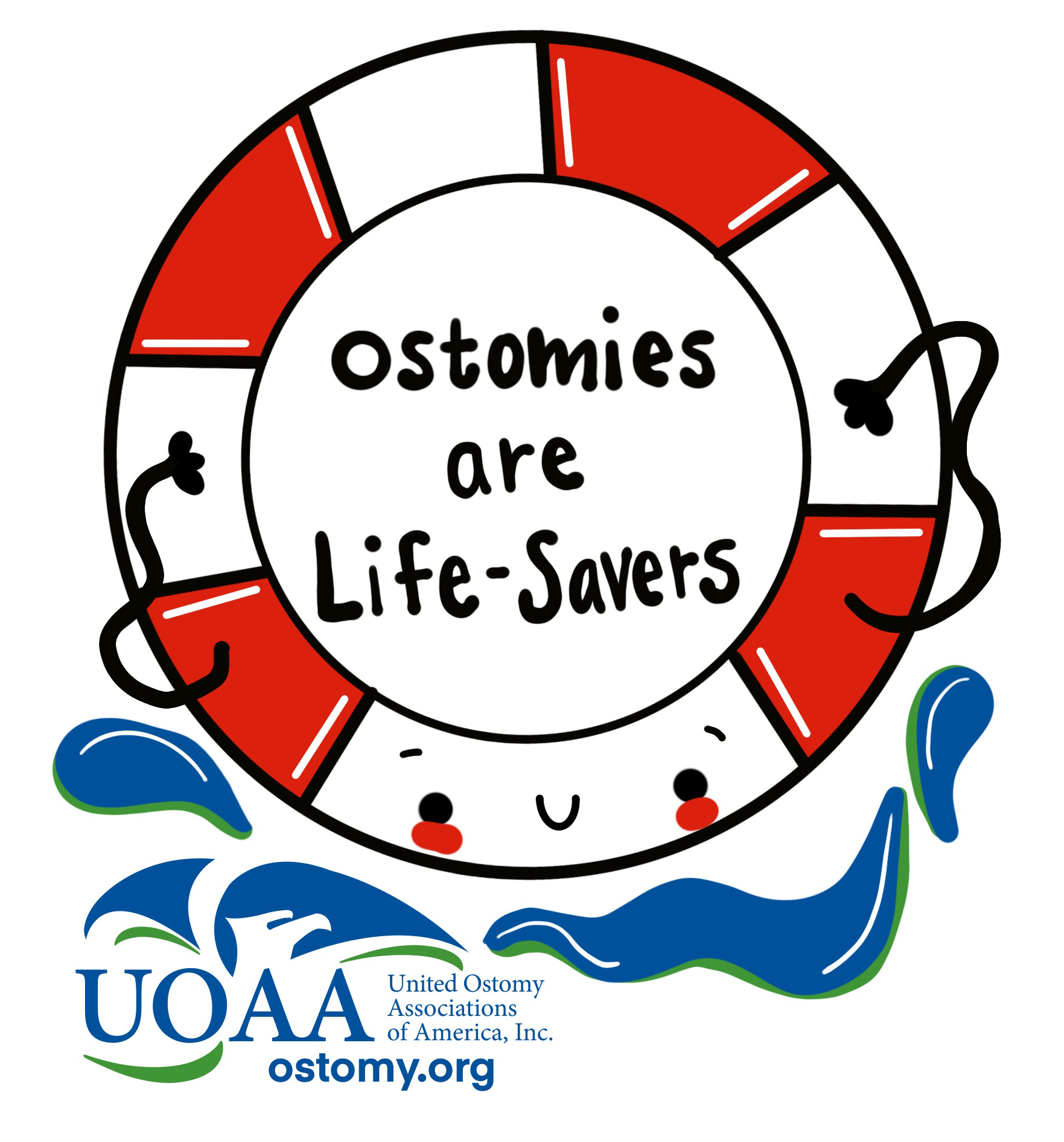 saved her life. She also wants to serve as an inspiration to other young people facing similar challenges and let them know they can “live the life they want because of the ostomy bag” and not in spite of it. Sydney exemplifies the resilience of the ostomy community.
saved her life. She also wants to serve as an inspiration to other young people facing similar challenges and let them know they can “live the life they want because of the ostomy bag” and not in spite of it. Sydney exemplifies the resilience of the ostomy community.
Liz exemplifies that resilience, too. A month and a half after being diagnosed with bladder cancer, she underwent a radical cystectomy (bladder removal) with a total hysterectomy and stoma placement. Liz is now an advocate who wants everyone to know that her urostomy saved her life. She and a fellow UOAA Support Group leader are hosting a Virtual 5k walk in Cincinnati because “we are living proof that ostomies are lifesavers and that you can have a fulfilling life with an ostomy.”
The need for an ostomy or other continent diversion isn’t always directly due to a medical condition. Stefphanie was hit by a drunk driver and underwent eleven surgeries in the two weeks following the crash and required both an ileostomy and a mucous fistula. Though hesitant to talk about it at first, she’s now thriving and wants to share her story to inspire others.
If you don’t want to run or walk yourself, consider shining a light on this resilience by supporting the fundraisers of people like these.
In Person Events Are Back This Year!
In addition to the Virtual Ostomy 5k which can be held anywhere by anyone, in-person Run for Resilience 5k events are back this year!
These events are family-friendly gatherings and a chance to share ostomy awareness in communities all around the country. Most events take place on beautiful parkland or waterfront trails. They also all feature an opportunity to visit with ostomy product representatives in person and visit other event sponsor tables. Race participants will also receive a goodie bag with promotional items and educational materials.
Don’t worry if you are not in running shape – do what you can. Walkers outnumber runners at many of these in-person fun runs. More serious runners looking for an event to attend however may want to travel to the Durham, North Carolina Run for Resilience Ostomy 5k as it takes place on a timed and certified 5k course.
Past participant Lianne Weller shared what makes these events special, “The 5k race allows other ostomates to build confidence and breakdown barriers to getting back into physical shape; going one step closer to their goal. I feel more confident and less self-conscious because I’m surrounded by individuals who have all gone through similar obstacles.”
As envisioned by the 5k founders, all locations will get an optional ostomy pouch provided by Exclusive Diamond Sponsor Hollister. Non-ostomates are encouraged to wear their ostomy pouches during the race. (Don’t worry. They’re easy to put on.)
The Arizona Run for Resilience Arizona 5k will have a great new location in Scottsdale on October 1st, 2022, with a 5k run/walk and a fun run for the kids.
The newest in-person event is the Miami, Florida Ostomy 5k taking place at the University of Miami Campus in Coral Gables on Saturday, October 1st, 2022, from 9:00 am to 3:00 pm. Organizer Ana Restrepo says the event will include food, drinks, games, giveaways, and more.
Other in-person Run for Resilience 5k events being held across the country in celebration of Ostomy Awareness Day on Saturday, October 1, 2022 are:
Birmingham, AL (October 8th)
(Please follow each individual link to get more information about times and types of races.)
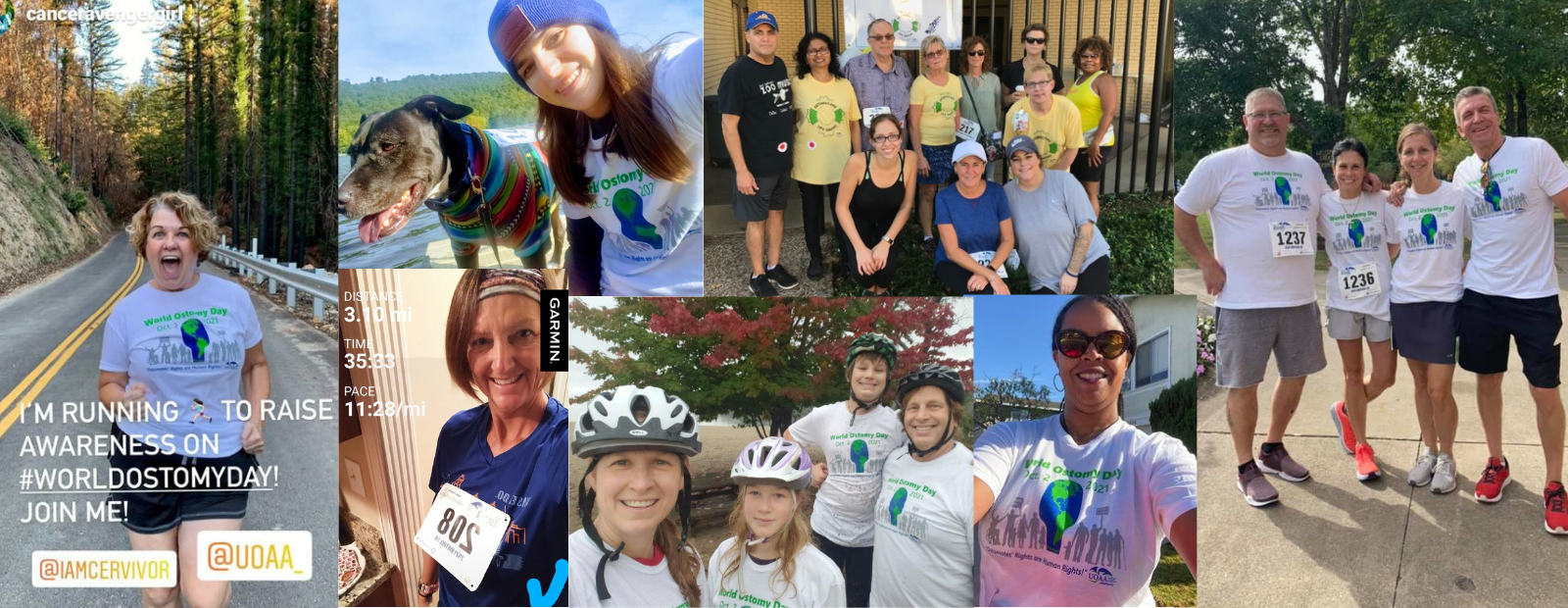
“I Intend to Be Victorious”
For every person living with an ostomy or other continent diversion, there’s a story of resilience to go along with it. A virtual participant who goes by Poo and Friends, is working to take their life back one step at a time and they “intend to be victorious.”
You can learn more about other participants of each race location or the worldwide virtual by clicking on the circle above their name and reading their story.
Don’t forget to click “Load More Fundraisers” to see them all, including Tanya who’s one of the many wonderful Certified Wound Ostomy Nurses (CWON) and Wound Ostomy Care Nurses (WOCN) taking part in the 2022 Run for Resilience Ostomy 5k.
Share Your Story Too
Are you someone who wants to help break the stigma around ostomies and be an inspiration to others? You’re encouraged to sign up, create your own fundraiser, and share your story. After all, the story of your journey can be what helps someone else make it through theirs.
To participate in the Virtual Ostomy 5k and get this year’s awesome Ostomies Are Lifesavers T-shirt in time for Ostomy Awareness Day you have to register by September 9th.
- Run, walk, roll or pedal a 5k (3.1 miles) route of your choice. You can even use a treadmill!
- Take pictures of yourself during your race and email them to info@ostomy.org or message or tag UOAA on Facebook, Instagram, Twitter, LinkedIn or TikTok
- Hashtag your photos with #OstomiesAreLifesavers and #RunforResilience
Friends, family, members of the medical community, and anyone else who wants to support ostomates and celebrate their resilience are also encouraged to donate or create their own fundraiser. Fundraisers will receive special promotional items depending on how much they raise.
Help Support UOAA
Funds raised during the 2022 Run for Resilience Ostomy 5k will support United Ostomy Associations of America (UOAA), a 501(c)(3) nonprofit organization that provides national advocacy, support and resources for the 725,000 to 1 million Americans who have had or will have ostomy or continent diversion surgery. These surgeries are lifesaving and have allowed many people to return to living a healthy life.
To find out more about the Run for Resilience Ostomy 5k please visit www.ostomy.org/5k.
Robin Glover is a writer based in the Houston area. He has a permanent ostomy after being diagnosed with Crohn’s Disease in 2017.
My journey to a Short Bowel Syndrome (SBS) diagnosis followed years of motility issues, intestinal complications and numerous surgeries, including a jejunostomy, which is an ostomy that creates an opening in the part of the small intestine called the jejunum. As a trained architect, I believe there’s no problem too big to solve, and applying that mindset has helped me to navigate the challenges of SBS and life with an ostomy. This is my story.
When I was diagnosed with a motility disorder at the age of 15, I never thought that it would have such an effect in my life. I was able to function with physical activity and limited diet until I had my colon removed in 2015 due to colonic volvulus. In my case, this meant that my colon twisted around itself, causing tissue death from lack of blood flow. The procedure worsened my underlying motility disorder of the small intestine. As a result of my underlying condition of chronic intestinal pseudo obstruction (CIPO), my intestines wouldn’t function. I lost the ability to absorb nutrients through my small intestine. I was in desperate need of answers.
Ultimately, I was evaluated for an intestinal transplant. At the time, my small intestine was severely compromised due to small intestinal bacterial overgrowth. In order to improve my odds of surviving the transplant, I underwent surgery to remove the majority of my small intestine in 2018, leaving me with only four inches of small intestine that didn’t function properly. The surgery, and the resulting serious and chronic malabsorption disorder that accompanied it, resulted in my diagnosis of short bowel syndrome, SBS.
To learn more about SBS, visit https://sbs-whattoknow.com/. To join the community and talk with others who are living with SBS, check out https://www.facebook.com/TakedaSBS/.
While not everyone will experience an SBS diagnosis the same way, for me, the removal of my colon and most of my small intestine eliminated the ongoing pain and discomfort I experienced when I was living with a motility disorder and chronic intestinal pseudo-obstruction syndrome. Just prior to the surgery to remove my small intestine, I weighed 87 pounds and couldn’t walk half a mile without becoming exhausted. I now weigh 122 pounds and was able to walk nine miles the other day. Keep in mind that this is just my experience and everyone’s journey will be different. In consultation with my medical team, I have decided to put my intestinal transplant on hold.
In my case, living with SBS also means that if I don’t eat the right things, it can affect my electrolytes and fluid balance. Without my colon, I don’t absorb fluids. So, I have found that if I drink water, I can actually lose fluids. A key part of managing my condition has been learning to listen to my own body and trying to understand what’s happening inside. For example, I have learned to recognize the signs of dehydration and have made it a priority to understand my lab values. As I have gained a better understanding of my condition, I also think it’s been important for me to find the right providers for what I’m going through at each stage of the process.
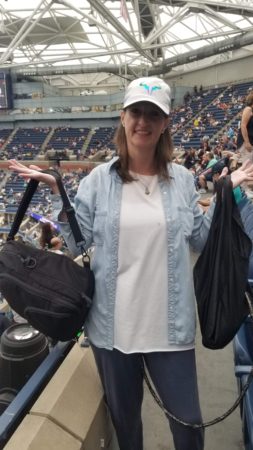
Navigating how to live with a jejunostomy was a challenging aspect in my SBS management, especially when I experienced leaking. I remember once going to a rare bookstore and my ostomy bag opened. In those moments, with liquid pouring down my legs, I had never felt more embarrassed. However, my grandma taught me that you have a choice in uncomfortable situations – you can either cry or laugh. I try to choose the latter. Not everyone will experience leaks with an ostomy, but if it happens to you, I’d encourage you to give yourself grace. Adapting to life with an ostomy can be a gradual process. For example, when I first had my jejunostomy, it took me an hour to change my bag and now it only takes me 15 minutes.
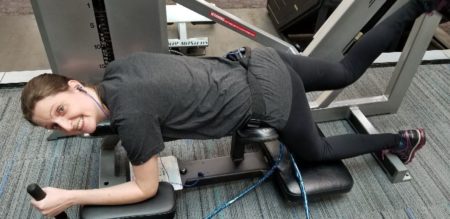
Despite the challenges, I never gave up on looking for answers and solutions. My training as an architect has led me to believe there is nothing that can’t be solved. After consulting with multiple ostomy teams and connecting with people who share similar experiences, I started to embrace the changes that came with my SBS diagnosis and jejunostomy.
I have been lucky enough to receive tremendous support throughout my SBS journey. My family is my biggest source of support. My husband has been there for me despite knowing about my chronic condition. My dad is the one who figured out how to empty the additional drainage bag overnight by flipping it upside down. My mother and grandma have created customized recipes to help with my oral food intake. But, for me, it’s been a continual process to educate the people around me about my condition. I have learned to be patient and vocal about my specific needs.
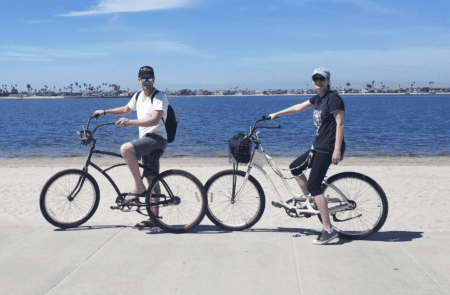
For anyone living with a rare and chronic illness, I encourage you to reach out and seek community support. A few members of the SBS community have inspired me and helped me to better understand my condition and encouraged me to break down barriers in my own SBS journey by sharing their own experiences. I’m grateful for the opportunity to connect with others going through similar experiences.
When I was first diagnosed with SBS, I did not think it would be possible to continue doing the things I love. Along the way, the architect in me has looked for opportunities to “design my future” with SBS by embracing challenges, educating myself and the people around me, and connecting with others in the community. I am proud of the progress I’ve made – I have a job that I love and I live in a city that I love. SBS is only a small piece of who I am, and it does not define who I am. I hope you can embrace YOUR journey with SBS, too.
This article was created by Takeda.
Editor’s Note: This educational article is from one of our digital sponsors, Takeda. Sponsor support along with donations from our readers like you help to maintain our website and the free trusted resources of UOAA, a 501(c)(3) nonprofit organization.
Are you a new ostomate? Or a soon-to-be ostomate? No matter how far you are in your ostomy journey, adapting to your new situation is an inevitable part of the process. Talking to others who have already been in your shoes can help you in adjusting to this time of your life. That’s why we asked Josh Nelson, the first active-duty U.S. Airforce Pilot living with an ileostomy, to share his story and his experience with his ostomy journey to give insights on how getting an ostomy can be just the beginning of an exciting new chapter.
Before surgery
What was your life like before your ostomy surgery?
I was diagnosed with ulcerative colitis in November of 2017. Throughout the next year after my diagnosis, I tried maximum medical therapies starting with oral medications, then biologics, and then transitioned to combination therapies with biologics. Unfortunately, my body just did not respond to the medications, and the disease just took over my life. If you want to talk about quality of life with ulcerative colitis before I had the surgery – I didn’t have one. I was 145lbs. I was having 18 to 20 bowel movements a day. I wouldn’t leave my house. I knew where every bathroom, rest stop, and gas station were from my house to where I work. Any time I did leave the house, the only thing on my mind was, “Where’s the bathroom?” in case I had that sudden urgency to go. My wife and daughters left me alone. They wouldn’t even ask if I would go with them anywhere because they just knew I did not want to go anywhere. I had no quality of life. I was a prisoner in my own home, and that’s no way to live your life.
How did you feel when you learned you would be having ostomy surgery? What questions of fears did you have?
I made the decision to have an ostomy surgery in November of 2018, and I had about three days’ notice before the surgery was going to take place. The staff at the University of Minnesota Medical Center, where I was inpatient for 30 days prior to surgery, did a great job of introducing what life with a stoma will be like. My questions were, “What is a stoma?” “What are the appliances that I’m going to have?” “How do I care for this thing, and how do I recover?” and “How do I slowly adapt to having an ileostomy and then getting my life back?” The WOC nurses were great, because they would just simply start to explain, “Oh, here’s what a wafer or barrier looks like,” “Here’s what a pouch looks like,” “Here’s what some of the accessories are.” They also explained, whether it’s ileostomy, colostomy, or urostomy, people do go on to live fully functional lives.
I definitely had some goals, but I had no fears when it came to having the surgery. I mean, okay, fine – I had maybe a couple fears of having surgery, but the stoma itself I was not afraid of. The reason for that is because I was kind of at my lowest of lows, and I thought to myself, “How could this be any worse than what I’m dealing with right now?” I remember my surgeon and the medical staff told me that once the surgery was done, I would no longer have the pain, and each day moving forward I could start to focus on getting my life back.
What advice do you have for people who are considering ostomy surgery?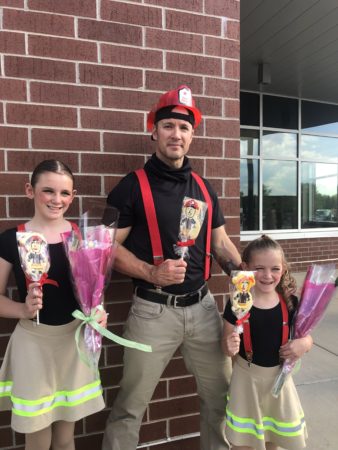
My advice to anybody who is considering having the surgery is to keep an open mind. It will take some work. You will need to adapt to what you have. That means taking care of yourself physically, mentally, and emotionally because it is a step-by-step process. It is a big transition, but I’ve done everything I could to make sure my quality of life has improved. I do not regret my decision one bit. I have my life back and that’s what I think is most important.
Coming home
What was your experience like right after your ostomy surgery?
I had about five days in the hospital after surgery, and during that time I was focused on recovery, protecting my abdomen, and getting my strength back. The nurses did a great job of explaining step by step what it takes to change out the pouch and care for my stoma. Before I left the hospital, I needed to make sure that my pain was under control, starting to move around, and understood how to change my appliance by myself.
What were your goals after your surgery?
I focused on transitioning to home life again, figuring out how to slowly heal my body, and how to start eating foods again.
My goals were:
- Getting healthy food into my body so that my body can recover.
- Finding out what schedule I should be on for changing out my appliance.
- Observing my stoma area regularly to keep my skin healthy, prevent skin breakdown, and make sure that my stoma was healing properly.
What would you tell someone else returning home from their surgery?
- Don’t be afraid of touching the stoma because your stoma doesn’t have any nerve endings you can feel.
- It’s extremely important to have a solid understanding of how to change your pouch and ask for products before you leave the hospital.
- Your WOC nurse will probably explain that what works best for you in the hospital may change after you go home and are healing up. Initially, it might be multiple times a week that you’re changing your whole appliance out because your abdominal area might’ve been swollen from the surgery, and as it starts to reside some of those wafers might fit differently.
- Everybody’s different. Everybody responds to products differently. Those first couple of weeks to a month is just trial and error to find out which products work best for you. After you figure out your change routine, your quality of life can start to improve. You no longer need to worry about having multiple leaks or having multiple issues with your appliance, and you can start to focus on making other goals for your life with an ostomy.
- Just take it day by day. Don’t think of the end state right away because it’s going to take time to get there. Create small goals on a day-to-day basis and then think long term and how to get there. It’s definitely a marathon; it is not a sprint. You’re going to learn something new every single day until you get comfortable living your life and understanding how to handle your ostomy.
Managing life with an ostomy
How has your life changed now that you have an ostomy?
I’ve had my ileostomy for over three years, and I can honestly say I haven’t looked back or had any regrets whatsoever to surgically remove my colon. I try to tell people my worst day as an ileostomate far exceeds my best day ever living under the umbrella of Inflammatory Bowel Disease. I am no longer bound by any type of medication. I have no special diet, nor do I have any restrictions, and my quality of life is through the roof. I could not be happier, and I do not regret the decision one bit whatsoever. But how did I get there?
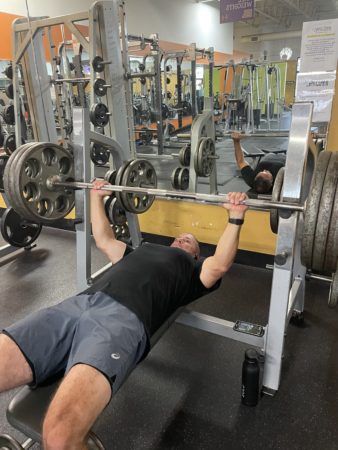 First off, I accepted the fact early on that I was going to have an ileostomy for the rest of my life because it was a decision I made for a better quality of life. After accepting it, I could focus on moving forward versus dwelling on the “how’s” and “why’s” with ulcerative colitis.
First off, I accepted the fact early on that I was going to have an ileostomy for the rest of my life because it was a decision I made for a better quality of life. After accepting it, I could focus on moving forward versus dwelling on the “how’s” and “why’s” with ulcerative colitis.
Secondly, after trying multiple different products, I came across a Coloplast product that worked really well for me. Once I found the product that worked well for me, that gave me the confidence to continue moving forward with my life and not have to worry about having leakage or skin issues. I have a couple routines, I’ll change my pouch no more than twice a week, but no less than once a week. I observe how the wear and tear of my wafer and appliance is working.
On top of that, I wanted to do everything that I could to make sure that I am living the best life that I can. I made some personal decisions, such as eating better and taking care of myself. I exercise quite a bit, and I try to eat fairly well. I try to focus on eating healthy foods so I can get the nutrition that my body needs.
What are some other tips you want to share about managing life with an ostomy?
It’s important to understand that this affects everybody differently, and it’s up to you to determine what works best for you to adapt, overcome, and live your life with any type of ostomy. I reached out to local support groups, and I think that’s extremely beneficial because you get connected with like-minded individuals. No matter whether they have a colostomy, ileostomy or urostomy, you can touch base with them and share your fears and concerns. A lot of these people have lived decades with their ostomy, and they’re proof to you that you probably can too. Finding that help and resource is extremely beneficial in helping you understand how to navigate life now that you have an ostomy and what’s out there for you.
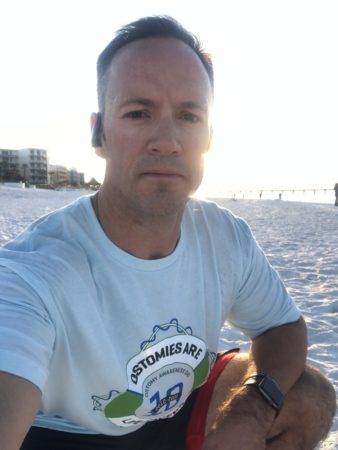
I hope this helped you to understand what it was like to be diagnosed with the disease, have a permanent ileostomy, and how I live my life moving forward. Thank you! -Josh
*Josh has received compensation from Coloplast to provide this information. Each person’s situation is unique, so your experience may not be the same. Talk to your healthcare professional about which product might be right for you.

At Coloplast, we strive to provide innovative solutions to support people with intimate healthcare needs and make their lives easier. Now, we’ve got an app for that!
If you’re looking for additional support during your ostomy journey, download MyOstomyLife by Coloplast® Care. The app is designed to help you be successful and build confidence in managing your ostomy by providing you with personalized tools and resources for your daily life with an ostomy.
With MyOstomyLife, you can create a digital stoma journal to track your pouching changes over time and easily download to share with your nurse, if requested. The app also provides you with educational resources offering reliable product and lifestyle advice, tips customized to your ostomy type, and inspirational videos from other ostomates like Josh.
You can also easily contact one of our Coloplast Care® Ostomy Advisors for product and lifestyle support within the app. We’re here to help!
Download MyOstomyLife for free on your smartphone or tablet today to get started!
Have any questions about the app? Visit Coloplast® Care at www.ostomy.coloplastcare.us or call
1-877-858-2656.
Information provided in the app and from Coloplast® Care is for educational purposes only. It is not intended to substitute for professional medical advice and should not be interpreted to contain treatment recommendations. You should rely on the healthcare professional who knows your individual history for personal medical advice and diagnosis.
Editor’s note: This article is from one of our digital sponsors, Coloplast. Sponsor support along with donations from readers like you help to maintain our website and the free trusted resources of UOAA, a 501(c)(3) nonprofit organization.
Finding Humor in life with an ostomy and IBD
My name is LTC(R) Justin F. Blum and I had my initial ostomy surgery 29 years ago and my rectum removed six years later. These surgeries were done because of an ulcerative colitis diagnosis that lead to colon cancer.
During the 1980s, I had many colonoscopies and a litany of medications, the Army assigned me to duty stations in Kentucky, South Carolina, Birmingham AL, and Fort Monroe VA. I started with 20mg of Prednisone per day and that went up to 240mg in the fall of 1992. During that following winter, I made an appointment with an Army gastroenterologist at Eisenhower Army Hospital, Fort Gordon GA. After the exam, he told me I needed to have ostomy surgery. I knew what an ostomy was, I raised
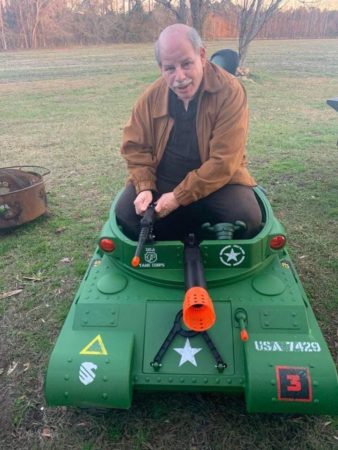
Still a tanker at heart!
my voice and said, “The only way I will have ostomy surgery is if my back is to the wall and I have one foot already in the grave”. Little did I know in one year I would be having that surgery. I was bleeding profusely while taking 240mg of Prednisone per day. My last colonoscopy showed that I had a large black spot on the transverse part of my colon.
My doctor immediately scheduled me for ostomy surgery at the end of February 1993. I was in the hospital for two weeks and proceeded to convalesce at home for 30 days. Three weeks into the leave, my wife and I tried having sex for the first time as an ostomate. My bag ended up going where no bag has ever gone before and probably had a better time than we did. After some maneuvering, life did get better! I reported back to duty in Birmingham AL after convalescent leave was over. I was eventually given a J Pouch which I had for four years.
My years with IBD and now an ostomy showed me that it takes a village to obtain a good quality of life.
The next few years living with my J-pouch were horrible. Despite taking 15 hospital strength Imodium per day, I was still defecating 20 times per day. I continuously was sore on my bottom. I would develop leaks and I ended up having to wear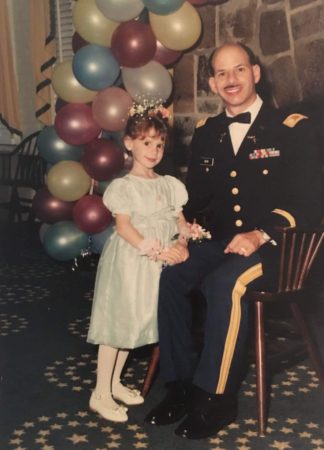 pantyliners in my underwear. When I retired from active duty in August 1996, I immediately started my second career as an Army JROTC Instructor in Bennettsville SC. I continued to go to the bathroom quite frequently and in the spring of the following year my daughter, who was six at the time, wanted me to play horsey with her and take her around the block. I bent down half in tears and told her that “daddy can’t play horsey because he is too sore on his bottom”. I immediately went to talk to my wife and we both agreed it was time to get back to having an ostomy bag. That summer at the Columbia SC Veterans Administration hospital, I had my third surgery to restore my ostomy due to my poor quality of life with the J Pouch. On the positive side, since I’ve had an external pouch, the veteran’s administration awarded me 100% total and permanent disability. I spent the next 23 years as an Army JROTC Instructor.
pantyliners in my underwear. When I retired from active duty in August 1996, I immediately started my second career as an Army JROTC Instructor in Bennettsville SC. I continued to go to the bathroom quite frequently and in the spring of the following year my daughter, who was six at the time, wanted me to play horsey with her and take her around the block. I bent down half in tears and told her that “daddy can’t play horsey because he is too sore on his bottom”. I immediately went to talk to my wife and we both agreed it was time to get back to having an ostomy bag. That summer at the Columbia SC Veterans Administration hospital, I had my third surgery to restore my ostomy due to my poor quality of life with the J Pouch. On the positive side, since I’ve had an external pouch, the veteran’s administration awarded me 100% total and permanent disability. I spent the next 23 years as an Army JROTC Instructor.
By the Fall of 1997, I was ready for my first formal engagement with my ostomy. The NAACP was conducting its annual scholarship banquet and I was one of the evening’s speakers. I made a very big mistake on the Saturday morning of the event by eating two packets of oatmeal for breakfast. I then went to a local bowling alley with my 6-year-old daughter for a birthday party. At the party, I ate too much popcorn! That evening my wife and children attended the dinner and I was dressed in my brand-new army dress mess uniform. I was sitting on the stage at the head table when it was my time to give remarks. Once I was finished with my remarks I looked down and I thought I had spilled some water on my lap. After a closer look, I realized that that was not water but wet feces seeping through my lap. I immediately got up and my wife and I proceeded to the nearest restroom. In the men’s room, my wife was straddling me with her body trying to clean off the feces from my pouch with one hand and trying to put on a new ostomy bag with the other. During this time three individuals came into the restroom and became startled because they thought we were having sex on the floor!
From 1997 to 2002 I would experience a lot of burning, stinging, and itching around my stoma. Unfortunately, I did not have access to an ostomy nurse at any of the two hospitals where I lived in Florence SC. To my good fortune, a new assistant WOC nurse was assigned to Carolinas Hospital. I called the nurse the next day and told her about the problems I was experiencing on my skin. She immediately asked if I could come in the next day for her to examine my broken skin. That next day she examined my skin and applied Nystatin Powder to the inflamed areas. Within two days the burning, stinging, soreness, and red skin started to heal very quickly.
Despite the ostomy pouch I worked very hard my first few years and to my happiness in 2003, was named the Army Junior ROTC instructor of the year for the entire worldwide JROTC system that consists of over 5000 instructors. In August of 2010 I received a letter from Cindy Norris, Carolina’s Hospital WOC nurse who enclosed an application for the ConvaTec sponsored Great Comebacks program. The Great Comebacks program identified ostomates that also accomplished acts in their lives of giving back to others. I mailed the application back for processing. The application highlighted my time with IBD and then in 1993 acquiring my ostomy while the whole time serving my country as an officer in the United States Army. In addition, in November 2009 I was promoted to the rank of full Colonel in the South Carolina State Guard. I received a phone call from former NFL Placekicker Rolf Benirschke with the great comebacks program. He told me I would be the recipient of the Tony Snow Award for Public Service. The Tony Snow Award was annually given to an individual who has an ostomy and performed years of public service to our nation.
In 2010 and 2011 I was honored to be recognized with several awards. I was named the 2010 volunteer of the year for South Carolina, the Tony Snow award winner, and in the summer of 2011, I was named for the second time the Army JROTC instructor of the Year. South Carolina Representative the Honorable Jim Clyburn recognized me on the floor of the House of Representatives in the summer of 2011 for these mentioned achievements while having an ostomy.
Eight years later I retired after 23 years as a JROTC instructor for a total of 44 years in uniform. My first act as a retiree was to apply to become a member of the United Ostomy Associations of America’s Board of Directors. To my good fortune, I became a board member and will have served a total of four years upon the conclusion of this tour of duty.
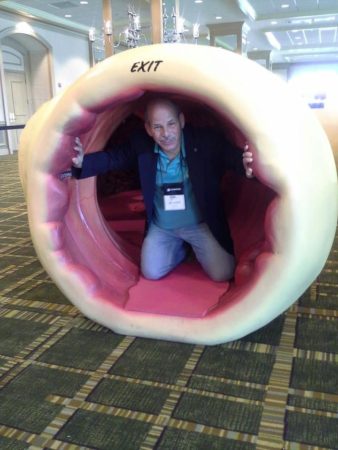
Justin at UOAA’s National Conference in Jacksonville , FL in August 2013. He now serves as a member of UOAA’s Board of Directors.
Over the four years, I was diagnosed and experienced neuropathy in conjunction with my ostomy. I was first put on a regimen of three 800mg tablets of Gabapentin per day which lasted six months. Not feeling any relief from the pain my doctor said we should try acupuncture. Apparently, the ears are where the acupuncture needles went because it was a central place for the pain sensors around my stoma. I was on acupuncture for about 3 months and unfortunately, I did not see any relief. My doctor prescribed Lyrica, which is a derivative of Gabapentin. I started with one tablet per day now I am up to three tablets after two months. My pain levels have gone down considerably and fortunately I have been able to start exercising again in moderation.
My years with IBD and now an ostomy showed me that it takes a village to obtain a good quality of life. My wife Leah, who I refer to as my “Chief of Staff” is the most important person in my village. She stood by my side during four surgeries and all the years of total discomfort. In addition, if not for my caring and loving wife, I never would have gotten through the transition from non-ostomate to being an ostomate. She is my go-to person for any of my problems and she is both sympathetic and empathetic to those problems. She also stood by my side during countless tours of duty with the Army bringing her continually farther away from her home in New Jersey. Ten years prior to my initial surgery, in 1993, my father died at the age of 61 from colon cancer that spread to his liver. My ostomy surgery gave me a second chance to live because I was a prime example that ostomies save lives! If I did not have my proctocolectomy, my young wife would have become a widow with three children all under the ages of seven.
I am also most fortunate to have three WOC nurses in my life: Joy Hooper, Donna Sellers, and Joanna Burgess-Stocks. I can contact any of those three nurses at any time of the day or night, especially Joanna, if I am having problems with my ostomy/neuropathy. A healthy support system is needed for anyone inflicted with these lifetime conditions. I have learned to always look at the positive side of life throughout all those years I had IBD and now my ostomy. Today I counsel individual ostomates who are having problems adjusting to their ostomy and speak to UOAA Affiliated Support Groups around the country via Zoom and share my story and listen to theirs. Remember, you’re not alone!
There’s no bond more important than the one with your own body. ConvaTec helps you create a healthy bond with yourself, your stoma. And then, with the world around you.
We want to show the world that people living with Ostomies have deep, beautiful nurturing relationships with everyone and everything around them.
This is Kya’s story: Coming out of the hospital postpartum and post-surgery, I honestly never thought I could never go swimming again. I never thought that I could get back to my normal life, I never thought I’d be my normal self. Turns out, I’m a better version of myself. I’m stronger and with Healthy Bonds, I am doing so much better. This is my life now. I used to think once I got an Ostomy that date nights would be stressful and less romantic, but I couldn’t have been further from the truth. Happy anniversary, baby.
Editor’s note: This blog/video is from one of our digital sponsors, ConvaTec. Sponsor support along with donations from readers like you help to maintain our website and the free trusted resources of UOAA, a 501(c)(3) nonprofit organization.
Contact Us

United Ostomy Associations of America
P.O. Box 2293
Biddeford, ME 04005-2293
Call us toll-free at: 1-800-826-0826.
Our Information Line hours are Monday-Friday, 9am to 3pm EST. If you have an emergency, please dial 911 or contact your local medical professional.
Please understand that UOAA is a private, nonprofit, advocacy and informational organization. We are not a medical facility and we do not have medical or legal professionals on staff. Therefore, UOAA does not provide Medical, Mental Health, Insurance or Legal Advice. Visit UOAA Virtual Ostomy Clinic provided by The Wound Company for non-emergency, virtual ostomy support.
Get Involved
UOAA is the leading organization proactively advocating on behalf of the ostomy community. Recognizing that we are always stronger together, we encourage everyone to get involved by joining our Advocacy Network. We’ve also created several Advocacy Tools and Resources to help you successfully advocate on behalf of the ostomy community to ensure every ostomate receives quality care.
Latest News:
 Do you speak stoma?April 4, 2024 - 2:32 pm
Do you speak stoma?April 4, 2024 - 2:32 pm Why Larry David’s “Colostomy Bag” Curb episode is making me speak out about my ostomy after 48 yearsMarch 28, 2024 - 10:43 am
Why Larry David’s “Colostomy Bag” Curb episode is making me speak out about my ostomy after 48 yearsMarch 28, 2024 - 10:43 am Osmani Gonzalez’s StoryMarch 12, 2024 - 12:20 pm
Osmani Gonzalez’s StoryMarch 12, 2024 - 12:20 pm Ostomy Advocates Taking Action in Washington, DC for Digestive DiseasesMarch 8, 2024 - 4:14 pm
Ostomy Advocates Taking Action in Washington, DC for Digestive DiseasesMarch 8, 2024 - 4:14 pm Sexual well-being and intimacy after ostomy surgeryFebruary 22, 2024 - 4:02 pm
Sexual well-being and intimacy after ostomy surgeryFebruary 22, 2024 - 4:02 pm

UOAA does not and shall not discriminate on the basis of race, color, religion (creed), gender, gender expression, age, national origin (ancestry), disability, marital status, sexual orientation, or military status, in any of its activities or operations.
